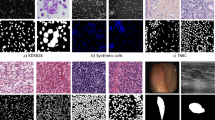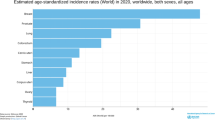Abstract
In the task of histopathological cell segmentation, traditional algorithms struggle with cell edge processing, which leads to the blurring of cell edges. To strengthen the ability to learn the features of cell edges, this paper develops a novel deep neural network for robust and fine-grained cell segmentation. The proposed deep model mines global and local features by multiscale convolution and dilated convolution. Subsequently, the residual attention module is introduced in the third to fifth layers of the encoder; this module assigns a group of weight coefficients to all the deep features to boost the segmentation performance. In addition, to further improve the quality of the features in the decoder, we first introduce the strategy of U-Net for the extraction of prior information, where we filter the fused features and compress the features by using the prior information and the filtered features again to integrate more semantic information into the feature refinement in the decoding process. We tested the model on three public data sets: Multiorgan Nucleus Segmentation (MoNuSeg) (Dice 94.9%), Triple Negative Breast Cancer (TNBC) (Dice 95.4%) and Data Science Bowl (Dice 98.2%). Extensive experiments demonstrate the superior performance of our proposed method in comparison with that of state-of-the-art models; our method can effectively identify cell edges to produce fine-grained segmentation results.





Similar content being viewed by others
References
Akil M, Saouli R, Kachouri R (2020) Fully automatic brain tumor segmentation with deep learning-based selective attention using overlapping patches and multi-class weighted cross-entropy. Med Image Anal 63:101692
An FP, Liu JE (2021) Medical image segmentation algorithm based on multilayer boundary perception-self attention deep learning model. Multimed Tools Appl 80(10):15017–15039
Badrinarayanan V, Kendall A, Cipolla R (2017) Segnet: A deep convolutional encoder-decoder architecture for image segmentation. IEEE Trans Pattern Anal Mach Intell 39(12):2481–2495
Bahdanau D, Cho K, Bengio Y (2014) Neural machine translation by jointly learning to align and translate. arXiv preprint arXiv:1409.0473.
Chen LC, Papandreou G, Schroff F, Adam H (2017) Rethinking atrous convolution for semantic image segmentation.arXiv preprint arXiv:1706.05587
Chhabra P, Garg NK, Kumar M (2020) Content-based image retrieval system using ORB and SIFT features. Neural Comput Appl 32(7):2725–2733
Fang X, Du B, Xu S, Wood BJ, Yan P (2020) Unified multi-scale feature abstraction for medical image segmentation. In: Medical Imaging 2020: Image Processing, vol 11313. International Society for Optics and Photonics, p 1131319
Fe I, Jiang W, Chen M, Yang Q, Tang X, Recognition P (2017) (CVPR). IEEE
Gao H, Cao L, Yu D, Xiong X, Cao M (2020) Semantic segmentation of marine remote sensing based on a cross direction attention mechanism. IEEE Access 8:142483–142494
Garg D, Garg NK, Kumar M (2018) Underwater image enhancement using blending of CLAHE and percentile methodologies. Multimed Tools Appl 77(20):26545–26561
Hamilton BA (2018) Kaggle. 2018 Data science bowl: Find the nuclei in divergent images to advance medical discovery. https://www.Kaggle.com/c/data-science-bowl-2018/
Kumar M, Chhabra P, Garg NK (2018) An efficient content based image retrieval system using BayesNet and K-NN. Multimed Tools Appl 77(16):21557–21570
Lee H, Hong H, Kim J (2018) BCD-NET: a novel method for cartilage segmentation of knee MRI via deep segmentation networks with bone-cartilage-complex modeling. In: 2018 IEEE 15th International Symposium on Biomedical Imaging (ISBI 2018). IEEE, pp 1538-1541
Lei B, Zeng X, Huang S, Zhang R, Chen G, Zhao J, Zhang G (2021) Automated detection of retinopathy of prematurity by deep attention network. Multimed Tools Appl 80(30):36341–36360
Li C, Tan Y, Chen W, Luo X, He Y, Gao Y, Li F (2020) ANU-Net: Attention-based Nested U-Net to exploit full resolution features for medical image segmentation, vol 90. Computers & Graphics, pp 11–20
Long J, Shelhamer E, Darrell T (2015) Fully convolutional networks for semantic segmentation. In: Proceedings of the IEEE conference on computer vision and pattern recognition, pp 3431-3440
Naylor P, Laé M, Reyal F, Walter T (2018) Segmentation of nuclei in histopathology images by deep regression of the distance map. IEEE Trans Med Imaging 38(2):448–459
Noh H, Hong S, Han B (2015) Learning deconvolution network for semantic segmentation. In: Proceedings of the IEEE international conference on computer vision, pp 1520-1528
Oktay O, Schlemper J, Folgoc LL, Lee M, Heinrich M, Misawa K, … Rueckert D (2018) Attention u-net: Learning where to look for the pancreas. arXiv preprint arXiv:1804.03999
Ronneberger O, Fischer P, Brox T (2015) U-net: Convolutional networks for biomedical image segmentation. In: International Conference on Medical image computing and computer-assisted intervention. Springer, Cham, pp 234-241
Shen W, Zhou M, Yang F, Yang C, Tian J (2015) Multi-scale convolutional neural networks for lung nodule classification. In: International conference on information processing in medical imaging. Springer, Cham, pp 588-599
Sinha A, Dolz J (2020) Multi-scale self-guided attention for medical image segmentation. IEEE J Biomed Health Inform
Thoben KD, Weber F, Giarda G (1998) Accelerating the exchange of information and experience about concurrent engineering: The CE Network of Excellence (CE-NET). In: Martensson N, Mackay R, Björgvinsson S (eds) Changing the Ways We Work-Shaping the ICT-solutions for the Next Century. Proceedings of the Conference on Integration in Manufacturing. pp 6-8
Tran ST, Cheng CH, Nguyen TT, Le MH, Liu DG (2021) TMD-Unet: Triple-unet with multi-scale input features and dense skip connection for medical image segmentation. In: Healthcare, vol 9. Multidisciplinary Digital Publishing Institute, p 541
Valanarasu JMJ, Oza P, Hacihaliloglu I, Patel VM (2021) Medical transformer: Gated axial-attention for medical image segmentation. arXiv preprint arXiv:2102.10662
Vidyarthi A (2020) Multi-scale dyadic filter modulation based enhancement and classification of medical images. Multimed Tools Appl 79(37):28105–28129
Wang Z, Zou C, Cui X (2020) Low-sample size remote sensing image recognition based on a multihead attention integration network. Multimed Tools Appl 79(43):32525–32540
Wang B, Wang L, Chen J, Xu Z, Lukasiewicz T, Fu Z (2020) w-Net: Dual supervised medical image segmentation model with multi-dimensional attention and cascade multi-scale convolution. arXiv preprint arXiv:2012.03674
Xia H, Sun W, Song S, Mou X (2020) Md-net: multi-scale dilated convolution network for CT images segmentation. Neural Process Lett, 51(3), 2915–2927
Xie X, Chen J, Li Y, Shen L, Ma K, Zheng Y (2020) Instance-aware self-supervised learning for nuclei segmentation. In: International Conference on Medical Image Computing and Computer-Assisted Intervention. Springer, Cham, pp 341-350
Yang J, Qiu K (2021) An improved segmentation algorithm of CT image based on U-Net network and attention mechanism. Multimed Tools Appl: 1–24
You H, Yu L, Tian S, Ma X, Xing Y, Xin N, Cai W (2021) MC-Net: Multiple max-pooling integration module and cross multi-scale deconvolution network. Knowl-Based Syst: 107456
Yu F, Koltun V (2015) Multi-scale context aggregation by dilated convolutions. arXiv preprint arXiv:1511.07122
Zhao H, Shi J, Qi X, Wang X, Jia J (2017) Pyramid scene parsing network. In: Proceedings of the IEEE conference on computer vision and pattern recognition, pp 2881-2890
Zhou Z, Siddiquee MMR, Tajbakhsh N, Liang J (2018) Unet++: A nested u-net architecture for medical image segmentation. Deep learning in medical image analysis and multimodal learning for clinical decision support. Springer, Cham, pp 3–11
Author information
Authors and Affiliations
Corresponding author
Ethics declarations
Conflict of interest
The authors have no relevant conflicts of interest to disclose.
Additional information
Publisher’s note
Springer Nature remains neutral with regard to jurisdictional claims in published maps and institutional affiliations.
Rights and permissions
About this article
Cite this article
Shi, T., Li, C., Xu, D. et al. Fine-grained histopathological cell segmentation through residual attention with prior embedding. Multimed Tools Appl 81, 6497–6511 (2022). https://doi.org/10.1007/s11042-021-11835-7
Received:
Revised:
Accepted:
Published:
Issue Date:
DOI: https://doi.org/10.1007/s11042-021-11835-7




